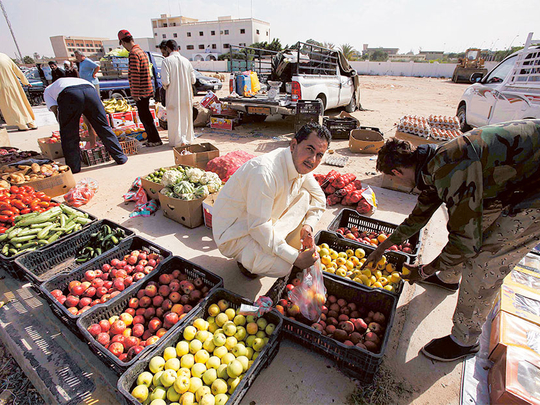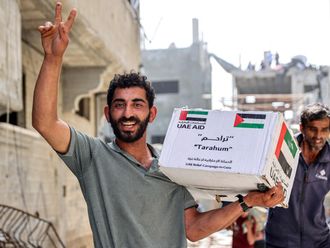
Sirte (Libya): The facade of the building that was once Col Muamar Gaddafi’s pride and joy is now daubed with the distinctive black and white militant flag. In streets nearby, mannequins in women’s clothes shops are covered in demure, shapeless black. Ladies’ hairdressers have been closed.
The Libyan dictator’s home city and pet project, later the scene of his capture and death, Sirte is now the first major foothold for the Daesh (Daesh) on the Mediterranean coast. A visit by The Daily Telegraph revealed how a small group of foreign fighters has developed into a force to be reckoned with, 300 miles from Italy’s shores.
“When they arrived they were just a small number,” said Milad, a resident, who spoke anonymously for fear of reprisals. “But then many locals joined them. They see them as the only way to have power in post-Gaddafi Libya.”
Backed by his tribe and allies, it was in Sirte that Gaddafi made his last stand in the 2011 war. The sprawling Ougadougou conference centre, which he built as a venue to play host to world leaders, is now Daesh’s headquarters. Snipers stationed on the rooftops looked down on the Toyota Hilux screeching past.
“They won’t shoot because they are afraid of us,” claimed the rival militia commander driving. Much of the east of the city is now in the hands of Daesh. District 2 and district 7, scene of Gaddafi’s last stand in 2011, is once again a no-go zone. Gaddafi lavished much of the country’s resources on Sirte, but it was into a city pounded into submission and abandoned to chaos that Daesh’s “caliph” Abu Bakr Al Baghdadi made his move two months ago.
In 2011, its villas and boulevards were reduced to rubble by Nato air strikes and artillery. Homes were looted and set on fire. With their leader gone and their city destroyed, the war left behind in Sirte a disaffected population, filled with hatred for Libya’s new rulers.
“Almost all of Sirte is still with Gaddafi,” said Milad. After the revolution, the power vacuum in Sirte, which rejected all of Libya’s competing factions, was filled with Ansar Al Sharia, a hardline Salafist militant group, mostly Libyan and many from Derna, historically a hub of fundamentalism. Although Ansar Al Sharia was accused of the killing of the American ambassador Chris Stevens in Benghazi in 2012, many Libyans still saw it as a positive force. “When Ansar Sharia arrived in Sirte they were not aggressive. They started giving classes to teach people their ideology,” Milad said. “They won people’s hearts with charity work, giving money and food to the poor.”
Then last August, Libya’s government split between rival militias, with the internationally recognised authorities forced to flee to Tobruk. The Islamist-leaning groups now in control of Tripoli and Misrata to the west, led by one called Libyan Dawn, formed an alliance with Ansar, despite its militant leanings. “Ansar had been ruling Sirte and we had no problem with them,” said Mohammad Lahal, operations commander with Libyan Dawn’s Brigade 166. Things changed again a few months ago when small numbers of foreign fighters began to arrive, swearing loyalty to Al Baghdadi.
“There are men from Egypt, Tunis, Syria, Algeria and many other places,” Lahal said. Milad said residents from abroad were the first to be targeted. “They killed an Egyptian doctor and his wife. Days later the body of his 17-year-old daughter was found.”
Daesh announced its arrival formally with a parade of pick-up trucks. From minarets’ loud-speakers, they declared Sirte part of their “caliphate”. The parade drove directly to Ansar’s headquarters. “Most of Ansar Al Sharia welcomed their arrival and swore allegiance to Al Baghdadi”, Lahal said. The group also worked hard to enrol former Gaddafi supporters.
In Iraq, Daesh’s takeover of Mosul and much of the north of the country was possible only after it brought Baathists, supporters of Saddam Hussain, into its ranks: men who wanted revenge against those who ended the dictator’s rule. It was the same in Libya, Lahal said. “When they arrived Daesh were very weak,” he said. “So they told all the men who had fought with Gaddafi that if they repented for helping a dictator and swore allegiance to Al Baghdadi they could join their group.
There are men with Daesh in Sirte who I recognise by face as men who fought on the side of Gaddafi in 2011.” One of the Daesh “emirs” in Sirte is said to be Hussain Karameh, a relation of Esmail Karameh, a senior figure in Gaddafi’s intelligence apparatus who is currently held in a jail in Misrata.
In the weeks since, Daesh’s grip has tightened. What under Ansar Al Sharia had been suggestions for living under “Islamic law” became orders, enforced with threats and payoffs. Then last month, the militants broadcast their control of the city to the world, beheading 21 captive Christians, all but one Copts from Egypt.
Showing the same violent flair for propaganda seen in Iraq and Syria, the video of the killings zoomed in on blood seeping into the sea, as a militant killer pointed across the waters and promised to advance to “Rome”. Western diplomats still say they see Libyan Dawn as the best hope for pushing out the extremists.
Thus far, though, many of its leaders have refused even to acknowledge a Daesh threat. “There is nothing called Daesh in Libya,” Jamal Zubia, its spokesman said. “The crazy international community says it’s Daesh. You know, it’s just the loyalists of Gaddafi trying to restore power.”
Other Libyan Dawn leaders see the battle with the recognised government in the east as a priority. Fathi Bashagha, a Libyan Dawn representative at UN-sponsored peace talks in Morocco this week, said Daesh could be defeated only after the formation of a unity government to stabilise Libya. Were Misrata militias to attack Sirte it would only drive support to the extremists, he said. While that may be true, it means Daesh’s killings will go for the moment unpunished. And in the meantime it strengthens its rule.
- The Daily Telegraph










